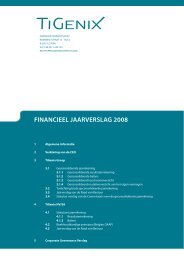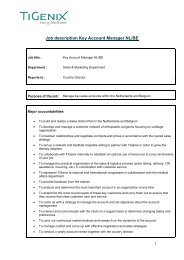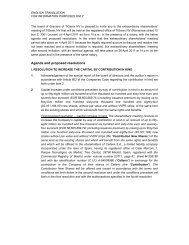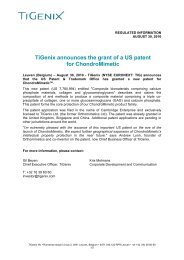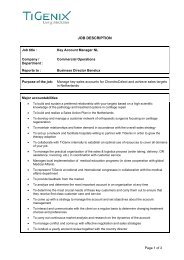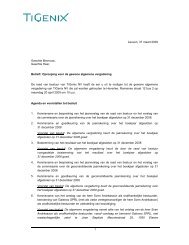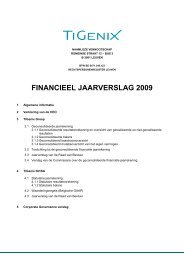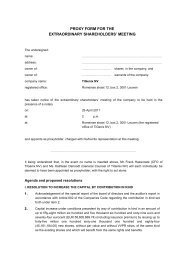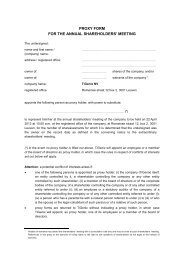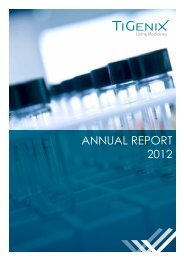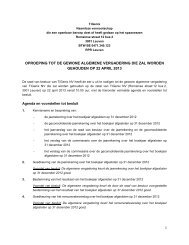ANNUAL FINANCIAL REPORT 2010 2010 - TiGenix
ANNUAL FINANCIAL REPORT 2010 2010 - TiGenix
ANNUAL FINANCIAL REPORT 2010 2010 - TiGenix
- No tags were found...
You also want an ePaper? Increase the reach of your titles
YUMPU automatically turns print PDFs into web optimized ePapers that Google loves.
1. The year in brief2009 was a very important year for Cellerix as it has reached itsfinancial targets and continued to develop its products.The Company’s Capital and Reserves have been strengthenedwith the conclusion of a financial round worth 27 million euros,approximately 20% of which had been paid in by year end.R&D spending in the year increased by 28%, due to the changesin product development.Other expenses increased mainly in respect of staff costsreflecting the strong growth in the workforce, which went froman average of 50 to 68 employees.EBITDA in 2009 was negative, as in previous financial years, asthe Company is currently in the development phase. For thesereasons we do not consider that the figures are comparablewith those of previous financial years.The 27th of August saw a milestone in terms of clinical trials,with the entry of the first patient into clinical trials for Phase I/IIIof Cx601. Also, the calendar marked for Phase III clinical trials ofOntaril for non-Crohn’s patients and of Cx501 for EpidermolysisBullosa continued on schedule.To sum up, these achievements show that the Company hascontinued to strengthen its domestic and international strategyin 2009, reaching its targets on schedule.2. ProductsCellerix’s products are based on innovative cell therapytechnologies.Ontaril uses expanded stem cells obtained from humanadipose tissue taken from the patient being treated, making itan efficient mechanism for treating complex perianal fistulasbased on the cells’ own anti-inflammatory properties. Complexperianal fistulas are a rare, painful and debilitating disorder thatfrequently affect patients diagnosed with Crohn’s disease orother inflammatory intestinal conditions. In clinical trials, Ontarilhas proven to be over 70% effective in completely closingcomplex perianal fistulas after 8 weeks of treatment. There areestimated to be around 69,179 cases a year in Europe (the 27 EUcountries plus Switzerland, Monaco, Norway and Liechtenstein).Ontaril’s effective action represents a new approach to celltherapies using adult stem cells, which could potentially beapplied to the treatment of other inflammatory disorders.Cx501 is an innovative chimeric skin graft that combinesexpanded cutaneous cells taken from the patient (autologous)and from a donor (allogeneic) to create a dermic matrix thatis less likely to be rejected by the patient, making it suitableas a long-term cutaneous repair treatment for sufferers ofEpidermolysis Bullosa Dystrophica Recessiva (EBDR). EBDR is anextremely debilitating hereditary skin disease that producessevere damage and blistering to the skin, and, in extremecases, causes the fingers to join together, a condition known assyndactylia.Given the relative rarity and serious nature of the conditionsfor which Cellerix is developing its products, and the scarcityof available treatments for them, both Ontaril and Cx501 havebeen designated as Orphan Drugs by the European MedicinesAgency (EMEA). This designation brings a number of benefitsfrom a product development standpoint, including researchgrants and subsidies, assistance and technical collaborationfrom the EMEA in the pursuit of clinical trials, a less costlyprocedure for obtaining regulatory approval to market theproducts in Europe, and exclusive marketing rights in Europefor ten years from the product launch date.Cellerix is also developing a new generation of products basedon the use of allogeneic expanded stem cells, i.e. obtained fromdonors (Cx601, Cx611 and Cx621).Cx-601 is the allogeneic version (from stem cells taken from adonor other than the recipient) of Ontaril. At the end of 2009the product is in phase II of its clinical development (obtainingpreliminary information on the effectiveness of the drug).The rest of the programmes are currently in the pre-clinicaldevelopment phase and are aimed at developing treatmentsfor fistulas and certain autoimmune disorders, respectively.3 •



